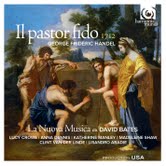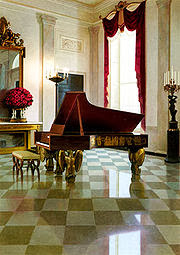In review--Greek shepherds find their nymphs
David Bates
Handel’s Il Pastor Fido
Harmonia Mundi
Love is a complicated matter for Italians. Remember the star-crossed lovers in Romeo and Juliet? Still, in another era, Italian troubadours roamed from court to court singing about unobtainable love. During the classical era, Italians fumbled their way through courtship in Mozart's operas. However, for George Frideric Handel during the Baroque era, nymphs and Greek shepherds endured Cupid’s painful arrows. Two couples appear at the center of the baroque opera Il Pastor Fido (The Faithful Shepherd) along with an early predecessor of the femme fatale who has her own plans.
Amarilli (soprano Lucy Crowe) is in love with Mirtillo (soprano Anna Dennis), but betrothed to Silvio (countertenor Clint van der Linde). However, Silvio made a vow to Diana, goddess of the hunt and he only has one thing on his mind. Dorinda (mezzo-soprano Madeleine Shaw), has fallen for Silvio and pursues the obsessed hunter. Meanwhile, Eurilla (soprano Katherine Manley), delivers a deceitful plot to rid of her rival Amarilli so she can claim Mirtillo as her lover. Now, I’m not sure why the male role of Mirtillo is performed by a soprano, but perhaps no one else could sing the stratospheric arias except a soprano. Back in Handel’s day, doctors performed a certain procedure on boys so that they could sing these high notes well into their adult years. Honestly, I don’t know the story behind this quirk, but I guess I’m supposed to suspend belief that a macho shepherd would have such a lovely feminine voice.
While the story itself falls on the pastoral side with a few dramatic moments, such as Silvio mistaking Dorinda for a wild animal during a hunt, or Eurilla framing Amarilli leading to her death sentence, the music delights. By the way, the performances on this recording dazzle. Handel did not compose music for the average person to sing. The heavily ornamented arias on this recording leave me with goose bumps. Baroque opera has different challenges than modern opera, where the singers carry the entire story, without special effects, or gigantic eye popping sets. These vocalists acted out their roles in a recording studio where they delivered a rich palette of emotions from giddiness caused by requited love to despair of a broken heart. The result is an entertaining opera that runs over two hours.
I would feel hard pressed to choose a favorite aria from this opera since Handel composed gorgeous arias that challenge vocalists. However, I will mention a few that deeply moved or delighted me. For an evil woman, Eurilla’s premature triumphant D’allor triofante si cinga provides a shining moment. Dorinda’s Se m’ami, oh caro offers a sweet lament from a woman who believes that she’s dying in the arms of her lover. Silvio’s guilt-ridden lament (he accidentally shot an arrow at Dorinda), Tu nel piagarmi il seno certainly feels heart-wrenching.
It’s not often that I listen to an opera. Reviewing an opera takes more work than reviewing other types of classical recordings. First, you have to read the text, read about the musicians, and the composer. Then you need to sit down with the actual music, and give it a thorough listen. However, I enjoyed spending a Sunday afternoon exploring Handel’s opera. I also feel honored to discover the young talented ensemble La Nuova Musica and it’s director David Bates. While you can read accolades this ensemble received in British press, you are better off listening to the recording and allowing it to pleasure all your senses. Who doesn’t enjoy a good love story sung in Italian?




Comments
Post a Comment